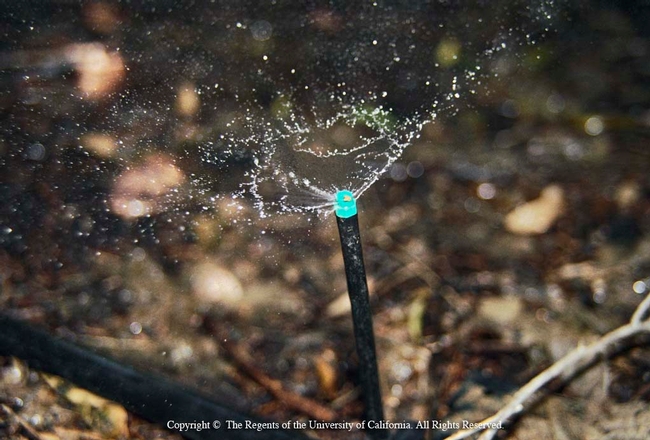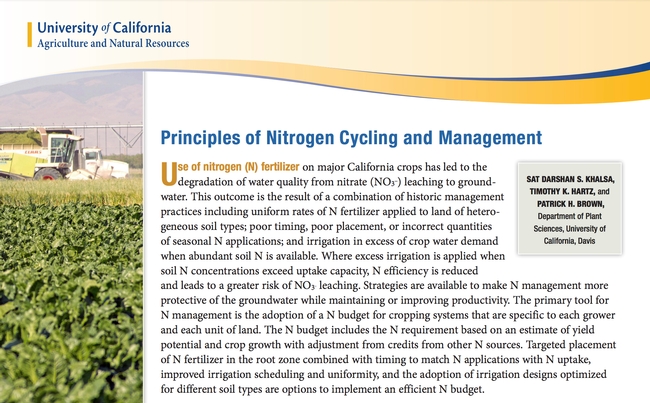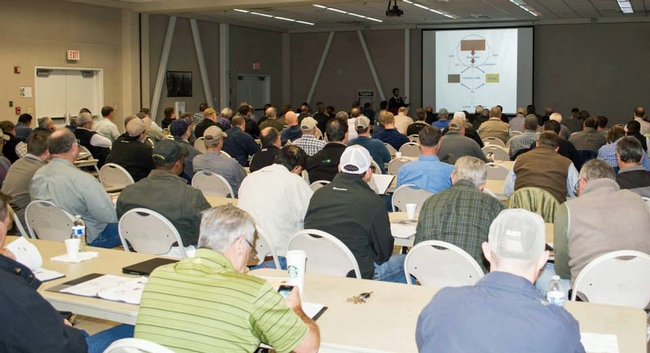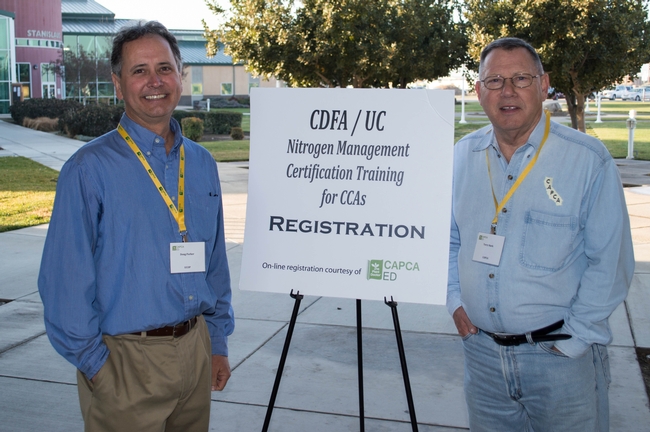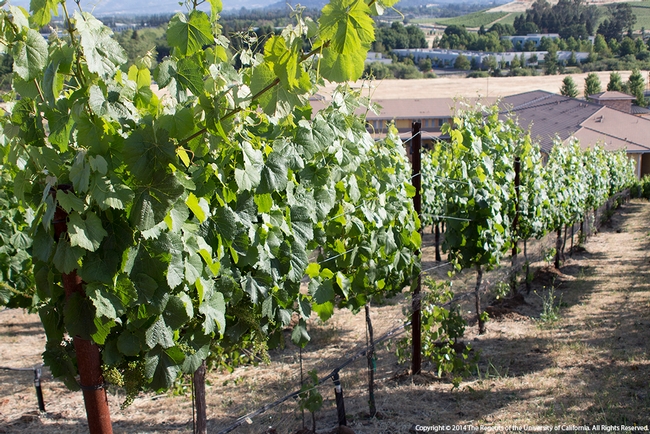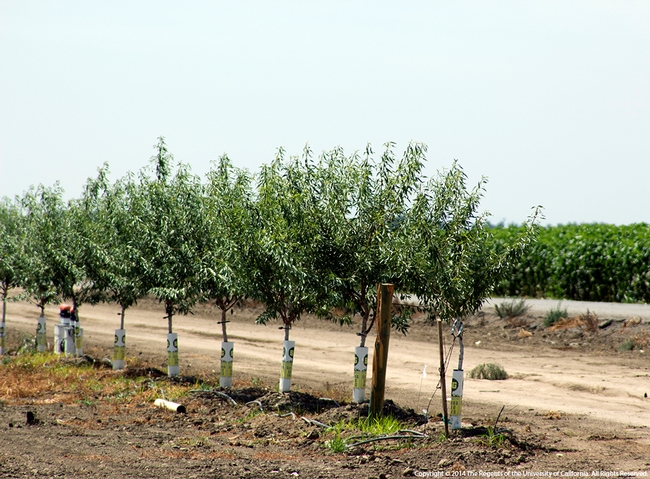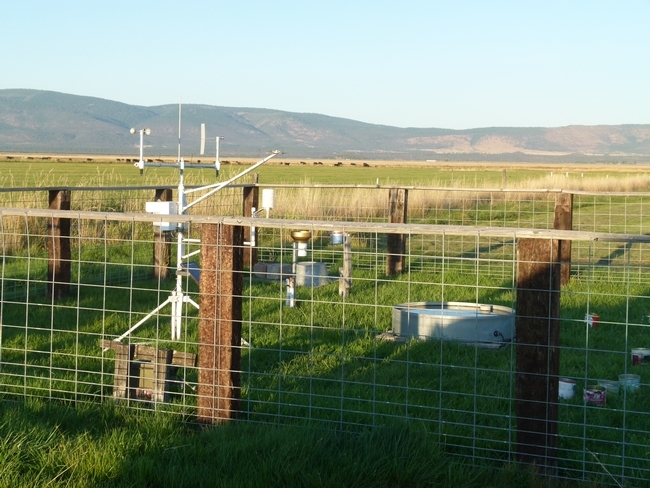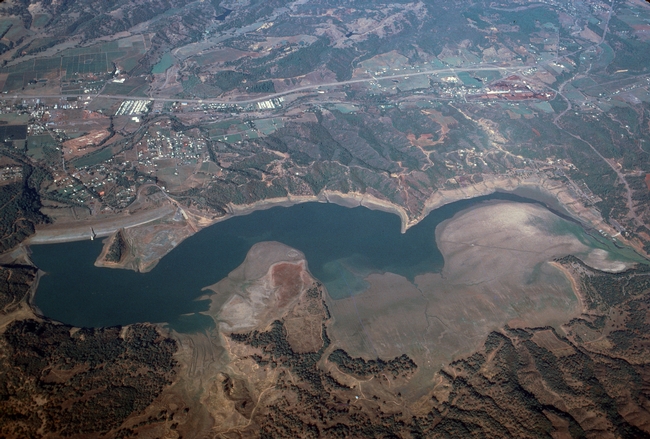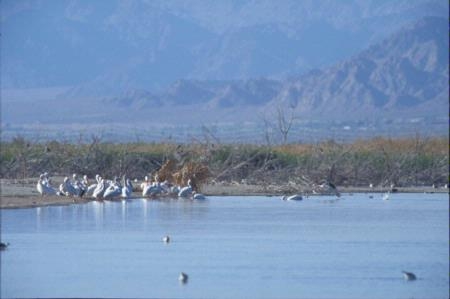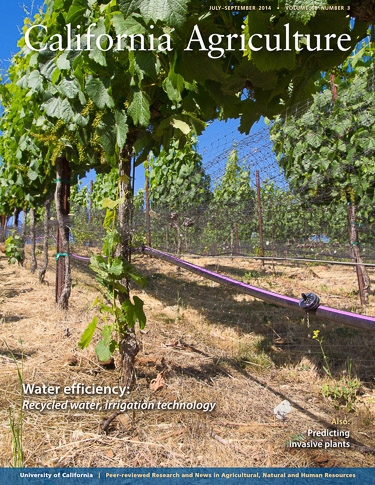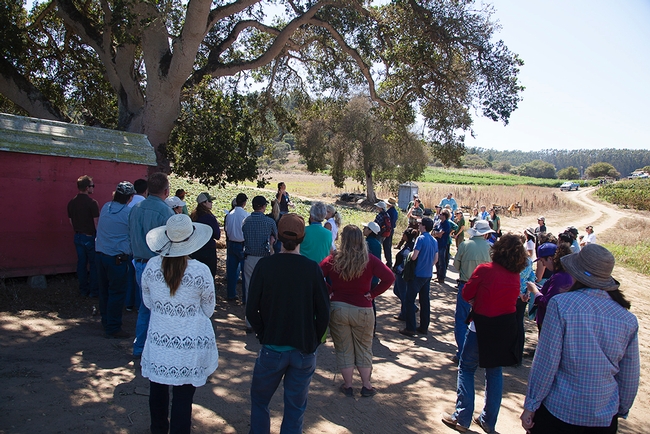Posts Tagged: water quality
UC ANR publishes nitrogen management advice for fruit, nuts and other crops
California growers can download a new series of publications summarizing efficient nitrogen management practices from UC Agriculture and Natural Resources. The publications are designed to assist growers in complying with state regulations for tracking and reporting nitrogen fertilizer applied to crops, in an effort to prevent nitrogen from leaching into groundwater.
The science-based publications are associated with a series of trainings for growers and Certified Crop Advisers to develop efficient nitrogen management practices, an effort coordinated by UC ANR's California Institute for Water Resources.
“Our role is to provide farmers, agricultural consultants and policymakers the best science possible for making decisions on managing and protecting California groundwater,” said Doug Parker, director of the water institute.
The free publications, created from training materials, lessons learned from the training sessions and from additional UC research, can be downloaded at http://ucanr.edu/nmgmtpublications.
The following publications are now available for download:
· Principles of Nitrogen Cycling and Management
· Irrigation and Nitrogen Management
· Nitrogen Management for Nut Crops
· Nitrogen Management for Deciduous Fruit and Grapes
· Nitrogen Management for Citrus and Avocado
· Nitrogen Management for Cool-Season Vegetables
· Nitrogen Management for Strawberry Production
· Nitrogen Management for Processing Tomato
· Nitrogen Management for Corn on California Dairies
The publications were authored by Parker of California Institute for Water Resources; Patrick Brown, professor in the UC Davis Department of Plant Sciences; Allan Fulton, UC Cooperative Extension advisor, Tehama County; Tim Hartz, UC Cooperative Extension specialist emeritus, UC Davis Department of Plant Sciences; Dan Munk, UC Cooperative Extension advisor, Fresno County; Daniel Geisseler, UC Cooperative Extension specialist, UC Davis Department of Land, Air & Water Resources; Michael Cahn, UC Cooperative Extension advisor, Monterey, Santa Cruz and San Benito counties; Richard Smith, UC Cooperative Extension advisor, Monterey, Santa Cruz and San Benito counties; Marsha Campbell, UC Cooperative Extension advisor emeritus, Stanislaus County; Sat Darshan Khalsa, UC Davis project scientist; and Saiful Muhammad, UC Davis graduate student.
Developed in 2014, the training program has been offered at 11 different locations around the state, most recently in Fresno. More than 1,000 Certified Crop Advisers have taken the training.
The nitrogen management training curriculum was developed by a group of UC ANR faculty, specialists and advisors. The first day focuses on the nitrogen cycle in crop production systems, nitrogen sources, irrigation and nitrogen management, and nitrogen budgeting. The second morning covers annual and permanent crops and nitrogen planning practices.
For more information on the nitrogen management training materials, visit http://ciwr.ucanr.edu/NitrogenManagement.
The Nitrogen Management Training and Certification Program is a joint effort between the California Department of Food and Agriculture, UC Agriculture and Natural Resources, California Association of Pest Control Advisers' Certified Crop Adviser Program and the Regional Water Boards.
What can California, Israel and Australia learn from each other about drought?
Drought management experts from Israel and Australia will join U.S. scientists in California for a workshop in Modesto on Jan. 12 and 13. Growers, crop consultants, irrigation practitioners, state agency members and others are invited to participate.
The two-day event, “Proven Solutions to Drought Stress: Water Management Strategies for Perennial Crops with Limited and Impaired Water Supplies,” is designed to foster conversation on a variety of drought management aspects and strategies. The drought workshop will be held at the Modesto Centre Plaza at 1150 9th Street in Modesto.
“California, Israel and Australia have all faced recurring drought conditions of varying severity and duration,” said James Ayars, research agricultural engineer of USDA Agricultural Research Service in Parlier, Calif., who spearheaded the event to bring together this prestigious group of scientists. “In view of more frequent and more severe recurring droughts in the years to come, it makes sense for us to pool our knowledge and plan more strategically for the future.”
Over the past 20 years, USDA and University of California scientists have developed several new approaches to help growers adapt to using water more efficiently. Several UC Davis, UC Cooperative Extension and California Department of Water Resources scientists will discuss their research approach and findings in California.
Other speakers include Shabtai Cohn, head of Israel's Agricultural Research Organization Soil, Water and Environmental Sciences Institute, John Hornbuckle, associate professor at Deakin University in Australia, and other researchers from Israel and Australia.
This workshop is sponsored by the USDA Agricultural Research Service, UC Agriculture and Natural Resources (UC ANR), UC California Institute for Water Resources and the Israel Ministry of Agriculture's Agricultural Research Organization.
“We hope to share expertise gained from experiences in our respective countries and learn new approaches for growing crops with limited water and poor quality water under the prospect of increased climate variability and change,” said Daniele Zaccaria, UC ANR Cooperative Extension specialist in agricultural water management in the Department of Land, Air and Water Resources at UC Davis and one of the event organizers. “Although Australia and Israel have very different climatic and socioeconomic conditions, there may be drought management strategies and policies that work in California that they can apply, and they may have practices and policies that we can adapt to address issues in California.”
Registration is $80 and includes lunch for both days. Dec. 18 is the deadline for early registration. After Dec. 18, registration is $120 until Jan. 1, 2016, and $150 after Jan. 1. There will be no on-site registration.
Certified crop advisers can earn continuing education units: Soil & Water Management 12.0 CEU and Crop Management 0.5 CEU.
To see the agenda and to register, please visit http://www.droughtmgt.com.
Lodging is available next to the Modesto Centre Plaza at the DoubleTree Hotel at 1150 9th Street in Modesto.
From fracking to water affordability, UC takes on new water-related research
Which California communities are more likely to vote down hydraulic fracturing? Are efforts to make safe, affordable drinking water more accessible working? These are among the questions University of California scientists are trying to answer with six new research projects funded by the UC Agriculture and Natural Resources' California Institute for Water Resources.
High-volume hydraulic fracturing, or fracking, a form of natural gas and oil extraction, is water-intensive and could exacerbate water stress. Gwen Arnold, professor in the Department of Environmental Science and Policy at UC Davis, is examining efforts to locally restrict high-volume hydraulic fracturing.
“There's a lot of concern over water pollution and water use in communities,” said Doug Parker, UC ANR California Institute for Water Resources director. “We're looking at the characteristics of communities that have voted on measures to restrict the practice of fracking, both where the measures have failed and where they've passed.”
Parker expects that people on either side of the issue will be able to use the study's finding to better understand differing viewpoints. Decision-makers who may be contemplating policy action on fracking will also benefit from seeing the range of relevant policies passed by other jurisdictions and the conditions that appear to favor or discourage adoption of the policies.
Another research project is assessing the Integrated Regional Water Management approach to address the lack of safe and affordable water in disadvantaged communities throughout the state. In 2011, the California Department of Water Resources funded seven pilot projects to develop models for improving water supplies for these communities.
“We want to take a look at how well Integrated Regional Water Management worked, whether it is meeting the needs of providing safe, affordable drinking water,” Parker said.
Jonathan London, professor in the Department of Human Ecology and director of the Center for Regional Change at UC Davis, and Carolina Balazs, UC presidential postdoctoral research fellow at UC Davis, are evaluating the impact of those efforts in Inyo-Mono counties, Santa Cruz, Los Angeles County, Kings Basin, North Coast, Imperial Valley and Coachella Valley.
- Roya Bahreini, professor in the Department of Environmental Sciences at UC Riverside, is looking at the relationship between water management and air quality in the Salton Sea region of southern California, where low water levels are leading to increased dust from the dry lakebed.
- Igor Lacan, UC ANR Cooperative Extension advisor in San Mateo-San Francisco counties, is investigating the performance of trees used in streetside stormwater management facilities, which are increasingly common in cities across California as communities look for ways to increase groundwater infiltration.
- Bruce Linquist, UC ANR Cooperative Extension specialist in the Department of Plant Sciences UC Davis, is quantifying methylmercury loads from rice fields to determine whether they may be of concern.
- Clarissa Nobile, professor in the School of Natural Sciences at UC Merced is using a high-tech metagenomic approach to research a potential problem for groundwater wells across the state: biofouling, which has the potential to be a costly challenge.
Learn more about these and other California Institute for Water Resources research projects by visiting http://ciwr.ucanr.edu/CIWR_Making_a_difference.
The California Institute for Water Resources integrates California's research, extension, and education programs to develop research-based solutions to the state's water resource challenges. An initiative to maintain and enhance healthy families and communities is part of the UC Agriculture and Natural Resources Strategic Vision 2025.
California Agriculture focuses on water efficiency
New UC research shows recycled water is suitable for Napa vineyards, but adds chloride to Salinas Valley soil.
Last year was California's driest on record, and we are now in our third straight year of drought. Growers have fallowed fields they can't irrigate, ranchers have sold cattle they can't feed, and the state wants cities to cut water use by 20 percent. The July–September 2014 issue of California Agriculture presents a special collection of original University of California research on water efficiency.
"This drought is unprecedented — we've never had such a lack of rainfall since we started keeping track," says Doug Parker, who directs UC ANR's California Institute for Water Resources and also leads UC ANR's Strategic Initiative on Water Quality, Quantity and Security. "Farmers are looking for ways they can stretch their water budget."
One way is irrigating vineyards with recycled wastewater from municipal waste treatment plants. California recycles only 7 percent of the 9 million acre-feet of urban wastewater produced per year, and the state wants to nearly quadruple that by 2030. Besides providing a source of irrigation water during drought, recycling water is cost-effective and reduces wastewater discharge to rivers.
To see if recycled water is suitable for use in Napa vineyards, UC Cooperative Extension researchers evaluated the quality of water treated by the Napa Sanitation District (NSD) as well as its impact on soil. They found that the quality of the recycled water was similar to that of other local sources of irrigation water. Additionally, in a vineyard that was irrigated with recycled water for 8 years, the soil did not accumulate salts or toxic ions, such as boron.
"Our work suggests that treated wastewater from the NSD is suitable for irrigation of vineyards over the long term," the researchers say.
One caveat is that the recycled water was relatively high in nitrogen. The higher soil nitrogen levels will be fine for many vineyards but, when needed, growers can easily reduce nitrogen by planting cover crops such as cereals and other grasses during the winter.
Also in this issue:
Recycled water increases chloride in Salinas Valley soil
Most growers in the northern Salinas Valley have irrigated their crops with recycled wastewater since 1998, raising concerns about salt accumulation in the soil. New research shows that since the year 2000, only a small amount of sodium has accumulated in the 12-inch deep rooting zone. In half of the fields studied, chloride has accumulated to levels that could affect yields of strawberry plants and leafy greens such as spinach. This chloride buildup may be due to the recent lack of winter rainfall, which normally washes salts out of the root zone, and could be mitigated by improving drainage and avoiding soil amendments that contain chloride.
Reducing runoff from alfalfa fields
Accounting for nearly 20 percent of total agricultural water use statewide, alfalfa is California's thirstiest crop — large amounts of irrigation water can be wasted as runoff. New UC research shows that alfalfa growers can reduce this runoff to a comparative trickle by using a mathematical model that predicts the advance of irrigation water across a field in combination with wireless sensors that track the water's advance. This new approach also frees growers from checking the irrigation status of fields in person, saving time and labor.
Predicting which plants will invade California
Most ornamental plants are happy to stay in gardens, but some jump the fence, invading wildlands and crowding out native plants. California has a wealth of native plants, about 3,400 species, but is also plagued by more than 1,500 species of invasive plants, many of which were introduced by the horticultural trade. New UC research identifies 186 ornamentals that have invaded Mediterranean areas in other parts of the world, and so are at high risk of becoming invasive here too. This work could help focus further risk assessments of imported ornamentals, as well as help land managers identify which species to watch for in wildlands.
The entire July-September 2014 issue can be downloaded at http://californiaagriculture.ucanr.edu.
California Agriculture is the University of California's peer-reviewed journal of research in agricultural, human and natural resources. For a free subscription, go to http://californiaagriculture.ucanr.edu or write to calag@ucanr.edu.
Growers, conservationists, food safety professionals discuss food safety, water quality
Growers, conservationists, food safety professionals discuss food safety, water quality
To help farmers and growers efficiently achieve the best results, the University of California Cooperative Extension, in collaboration with the Farm Food Safety and Conservation Network brought together 80 people on Aug. 21 for the sixth annual Food Safety and Water Quality Co-management Forum in Watsonville.
"The Farm, Food Safety & Conservation Network is leading the way in co-management of California's agricultural resources,” said Craig McNamara, president of the California Board of Food and Agriculture. “Their recent forum on food safety and water quality brought together the best and the brightest from the Central Coast region to discuss these important issues."
McNamara, who was the keynote speaker, provided his perspective on broadening the view of food safety to include managing agriculture within the context of sustainable agriculture, ecosystem conservation and food insecurity. He also related the discussion of co-management to California’s Ag Vision 2030, a stakeholder-driven process of setting priorities for the future of California agriculture.
Forum participants heard the latest information on designing on-farm practices that might create co-management solutions for nutrients, pesticides and pathogens in the production environment. They also engaged in frank discussion of co-management challenges and solutions at all levels of the supply chain, from large company policies to field-level practices of individual growers.
“Research results show us that we do know quite a bit’ explained Mary Bianchi, UC Cooperative Extension advisor in San Luis Obispo and Santa Barbara counties. “The question now is how do we put that knowledge into action? How can we move towards design and management of on-the-ground management practices and policy programs that reflect our evolving understanding?”
The forum concentrated on the types of practices and policy programs that may help, and discussed strategies, both field-based and policy-driven, that might support progress in addressing persistent resource concerns relevant to agricultural production.
“The forum presents a great opportunity for anyone interested in learning about the key co-management issues on the Central Coast and is a great way to network with experts in the field,” said Afreen Malik, Ocean Mist Farms manager of Food Safety and Environmental Stewardship.
Scientists led a discussion on the fate and transport of nutrients, pesticides, and pathogens and how science can be applied to design practices for co-management decisions in the field. The scientific panel included Tim Hartz, UC Cooperative Extension specialist in the Department of Plant Sciences at UC Davis; Rob Atwill, UCCE specialist in the School of Veterinary Medicine and director of the Western Institute for Food Safety and Security; and Brian Anderson, UC Davis specialist based at the Marine Pollution Studies Laboratory at Granite Canyon.
A panel of industry leaders discussed how policy changes and decision-support tools could support sound co-management. The panel included Ken Harris, executive officer of the Central Coast Regional Water Quality Control Board; Asif Maan, branch chief of CDFA Feed, Fertilizer, and Livestock Drugs Regulatory Services; Kris Gavin of Growers Express; Scott Horsfall, CEO of Leafy Greens Handlers Marketing Agreement; and Lisa Lurie of Santa Cruz Resource Conservation District.
Following the panel discussions, participants visited an organic vegetable and berry farm near Watsonville. The landowner, growers and food safety professionals discussed how they manage for both food safety and environmental quality, which some people see as conflicting priorities.
“I don’t see any conflicts between properly implemented co-management practices and protection of water quality,” said Ken Harris, executive officer of the Central Coast Regional Water Quality Control Board after completing a field exercise at the ALBA Triple M Ranch outside Watsonville.
Brendan Miele, director of California farming operations for Jacobs Farm/del Cabo Inc., added, “I would say the same thing, but would change that to food safety.”
Participants were surveyed before and after the forum. “After the forum, 88 percent of the participants felt they understood co-management principles, 14 percent higher than before the forum,” Bianchi said, “and 85 percent of the participants felt that they could incorporate what they learned into the decisions they make.”

